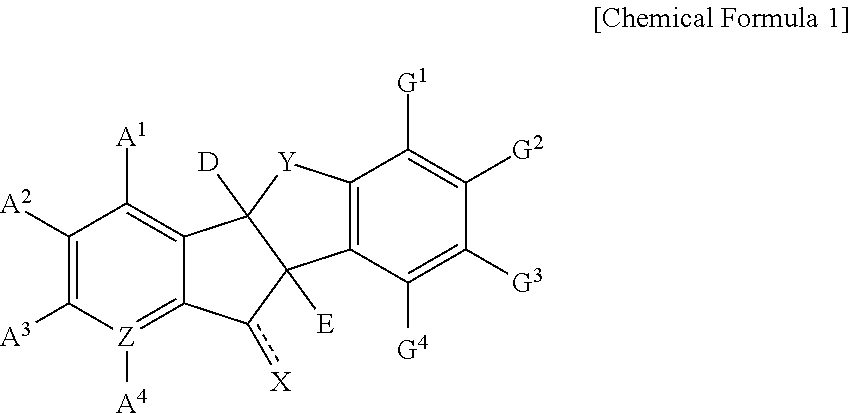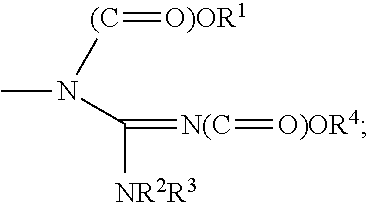Indanone derivatives, pharmaceutically acceptable salts or optical isomers thereof, preparation method for same, and pharmaceutical compositions containing same as active ingredient for preventing or treating viral diseases
a technology of indanone and derivatives, which is applied in the field of indanone derivatives, pharmaceutically acceptable salts or optical isomers thereof, preparation methods thereof, and pharmaceutical compositions containing same as active ingredients for preventing or treating viral diseases, can solve the problems of compound observation of insignificant or few therapeutic effects, no therapeutics for curing these diseases, and no vaccines for coxsackieviruses, echoviruses, rhinoviruses, etc., to achieve excellent inhibitory activity, low cytotoxicity
- Summary
- Abstract
- Description
- Claims
- Application Information
AI Technical Summary
Benefits of technology
Problems solved by technology
Method used
Image
Examples
example 1
4b,9b-Dihydroxy-7-methyl-4bH-benzo[d]indeno[1,2-b]furan-10(9bH)-one
[0426]Ninhydrin (6.00 g, 33.6 mmol) and m-cresol (3.78 ml, 33.6 mmol) were dissolved in acetic acid (30 ml) and heated for 3 hrs under reflux. After cooling, the precipitate thus formed was washed with acetic acid and water in that order to afford the title compound as a white solid. 7.55 g (83%).
[0427]mp: 145-147° C.
[0428]1H-NMR (300 MHz, CDCl3) δ 2.26 (s, 3H, CH3) 6.63 (s, 1H, ArH) 6.75 (d, J=7.8 Hz, 1H, ArH) 7.34 (d, J=7.8 Hz, 1H, ArH) 7.54 (t, J=7.5 Hz, 1H, ArH) 7.74-7.81 (m, 2H, ArH) 7.97-8.00 (d, J=7.8 Hz, 1H, ArH). MS (EI): 268
example 2
7-Methyl-10-oxo-9b,10-dihydro-4bH-benzo[d]indeno[1,2-b]furane-4b,9b-diyl diacetate
[0429]4b,9b-dihydroxy-7-methyl-4bH-benzo[d]indeno[1,2-b]furan-10(9bH)-one (1.00 g, 3.7 mmol) was completely dissolved in anhydrous dichloromethane (50 ml). This solution was added with anhydrous acetic acid (0.7 ml, 7.4 mmol), pyridine ml, 3.7 mmol), and 4-dimethyl aminopyridine (0.1 g), and stirred at room temperature for 3 hrs. After the reaction mixture was extracted with dichloromethane, the organic layer was concentrated and purified using column chromatography (ethylacetate:hexane=1:8) to afford the title compound. 0.04 g (3%).
[0430]mp: 167-169° C.
[0431]1H-NMR (300 MHz, CDCl3) δ 2.15 (s, 3H, OAc) 2.16 (s, 3H, OAc) 2.30 (s, 3H, CH3) 6.69 (s, 1H, ArH) 6.88 (d, J=7.8 Hz, 1H, ArH) 7.47 (d, J=7.7 Hz, 1H, ArH) 7.58 (1, J=7.4 Hz, 1H, ArH) 7.75-7.84 (m, 2H, ArH) 8.14 (d, J=7.7 Hz, 1H, ArH). MS (EI): 352.
example 3
Ethyl 2-(4b,9b-dihydroxy-6-methoxy-10-oxo-9b,10-dihydro-4bH-benzo[d]indeno[1,2-b]furane-8-yl)acetate
[0432]Ninhydrin (2.54 g, 14.2 mmol) and ethyl-2-(4-hydroxy-3-methoxyphenyl)acetate (3.00 g, 14.2 mmol) were dissolved in acetic acid (15 ml) and heated for 21 hrs under reflux, followed by extraction with ethylacetate. The concentrate was purified using column chromatography (ethylacetate:hexane=1:1) to afford the title compound. 1.46 g (29%).
[0433]mp: 133-136° C.
[0434]1H-NMR (300 MHz, CDCl3) δ 1.20 (t, J=7.2 Hz, 3H, CH3) 3.56 (s, 2H, CH2) 3.82 (s, 3H OCH3) 4.11-4.18 (q, J=7.2 Hz, 14.4H, 2H, OCH2) 6.89 (s, 1H, ArH) 7.12 (s, 1H, ArH) 7.56-8.14 (m, 4H, ArH). MS (EI): 370.
PUM
 Login to View More
Login to View More Abstract
Description
Claims
Application Information
 Login to View More
Login to View More - R&D
- Intellectual Property
- Life Sciences
- Materials
- Tech Scout
- Unparalleled Data Quality
- Higher Quality Content
- 60% Fewer Hallucinations
Browse by: Latest US Patents, China's latest patents, Technical Efficacy Thesaurus, Application Domain, Technology Topic, Popular Technical Reports.
© 2025 PatSnap. All rights reserved.Legal|Privacy policy|Modern Slavery Act Transparency Statement|Sitemap|About US| Contact US: help@patsnap.com



